
Hot Topics
Selling the BENEFITS, Not the FEATURES
September 9, 2015
People do not buy features. They buy solutions to problems or needs. The more work we make them do to understand how working with us will meet those needs, the lower the chance they will ‘get it’ and the lower our chance of making a sale. No one wants to work with us if we don’t put their wants, passions, and perceived needs first. Our prospects are only interested in doing business with us to the degree that they understand what we can do for them. In every presentation we write, we must remember that our prospect’s desires, anxieties, and aspirations must always come before our own.
Put yourselves in your prospect’s shoes and review the list of features. Ask, “What’s in it for me?” The “what’s in it for me” is the benefit the prospect will want to buy. You will want to consider these questions about each feature on your list:
- What do our clients get from this feature? How much? How often?
- Why does the feature matter?
- What problem does this feature solve?
- How well does it solve the problem?
A feature becomes a benefit when it intersects the life of a human being with favorable results. The favorable result is the benefit we want to present to prospects.
These words can be used as thought-starters for turning your features into benefits: solves, answers, helps, protects, enhances, fixes, satisfies, saves, gains, assists, serves, maintains, increases.
Then refine your list to create a master benefit list for your station.
- Review the list of benefit statements you created from the features.
- We want to focus only on those statements that have clear benefits to prospective clients.
- Decide as a group which benefits offer the best solutions to prospective clients’ problems or fulfill a physical need (save them time, money, resources, etc.) or emotional need (make me look smart, successful, important, etc.).
- If the group cannot define a clear result that will fulfill a client’s needs or address and solve a problem, remove it from your list.
- Not every feature is going to have a strong benefit.
- Some features may have more than one benefit.
Keep the strongest 20 to 30 benefit statements as the master list and use them in your proposals and presentations.
Not every benefit on your list is relevant for every prospective client. In your discussions, presentations, and proposals, you should only include those benefits that address that particular client’s needs, wants, and emotions.
- Review the needs analysis you performed for the prospect.
- What are that client’s specific needs and problems? Rank these in order of importance to the client.
- Which benefits will help solve your prospect’s needs? Rank the benefits in order of importance to the prospect.
- If you are meeting with more than one decision maker, address each of their needs and concerns. The motivating factor to work with you will be different for each of them.
- Open your discussions, proposals, and presentations with the benefits that are most important to your prospects. People always want to know what’s in it for them first. Don’t make them search through your proposals to find out what’s in it for them. Put the benefits in the headline, in the opening paragraph, in the offer, throughout the bullets, and all the way to the final sentence.
- By discussing only those benefits relevant to the prospect, you will illustrate that you have listened to, understood, and addressed their particular needs and they will be more inclined to work with you and your station.
When you are in a sales situation, listen to yourself. Are you enthusiastically discussing the excellent features of your station and overlooking the benefits that will motivate the prospects to buy from you?
We invite you to share some of your station’s strongest benefits with us below.
-Nakia Smith, Sr. Sales Research Consultant

Comments